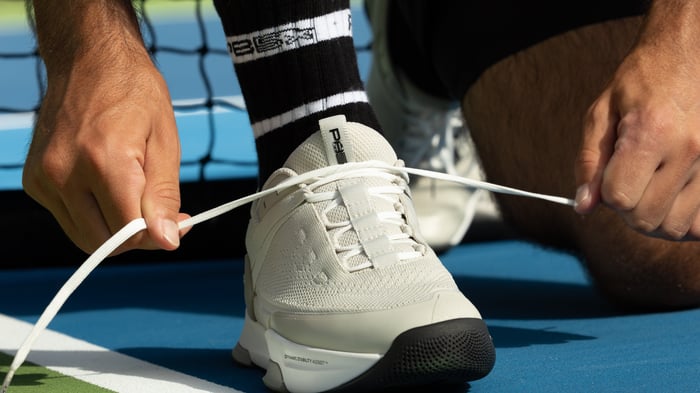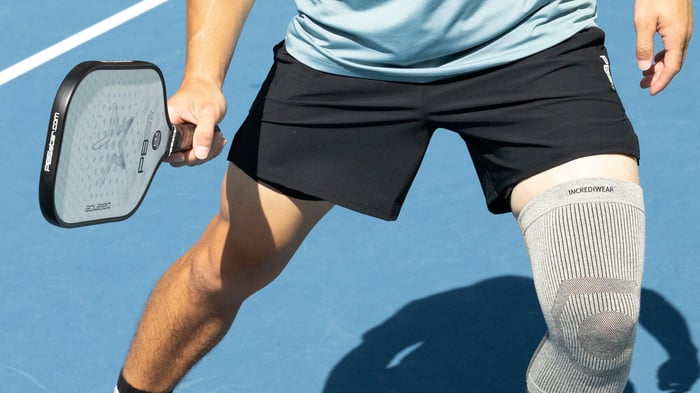Key takeaways:
Structured pickleball drills are essential for building muscle memory, improving decision-making speed, and gaining a competitive edge on the court.
Targeted practice sessions focusing on specific skills like third shot drops, dinking, and volley control can transform weaknesses into strengths and elevate your game.
The right performance-ready gear enhances your training by ensuring comfort, mobility, and focus during intense practice sessions.
What transforms casual court time into game-changing improvement? The answer lies in how intentional practice shapes your brain. Research shows that consistent drilling strengthens neural pathways and affects how quickly skills can be learned and executed during gameplay. Every focused rep you take builds the muscle memory and decision-making speed that separates players who plateau from those who continue climbing the competitive ladder. When you commit to structured practice, you're not just hitting balls—you're rewiring your brain for peak performance.
When you focus on the right training methods, this neurological advantage becomes your competitive edge. Essential pickleball drills target the specific skills that matter most in match situations: precise shot placement, lightning-fast reactions, and strategic court positioning. Rather than hoping general play will improve your game, these focused training sessions help you play smarter and stronger in every point, turning weaknesses into weapons and good shots into game-winners. The most effective drill sessions happen when you can move freely and stay comfortable throughout intense practice, which is why performance-ready gear becomes part of your training strategy. Check out PB5star’s collection to support your most productive sessions on the court.
#1. Master the third shot drop drill
The third shot drop represents your strategic bridge from defensive baseline play to offensive net control. When executed properly, this shot transforms you from a reactive player into the one dictating pace and positioning. The beauty of this shot lies in its ability to neutralize attacking opponents by forcing them into patient, controlled exchanges rather than the fast-paced rallies they prefer.
The most effective third shot drop drill focuses on consistency and touch rather than perfection. Try the "0 to 60" method: position one player at the non-volley zone while the other starts at the baseline. The net player feeds deep balls, and the baseline player attempts consecutive successful drops into the kitchen, aiming for a cumulative score of 60 points. Let the ball drop to knee height before striking, focus on hitting upward with a short backswing, and move forward during your shot.
Avoid the common mistake of rushing the contact point or using too much wrist action, which often sends balls sailing long or into the net. This drill builds the muscle memory needed to execute under pressure while developing the soft touch that transforms adequate drops into game-changing weapons.
#2. Build consistency with the dinking drill
Dinking helps you neutralize aggressive players who make unforced errors when forced into patient exchanges. This soft, controlled shot that lands in the kitchen compels your competition to slow down their attack and engage in methodical rallies where accuracy matters more than power. Understanding the dink as a strategic weapon rather than a defensive necessity changes how you approach net play, turning what many consider a boring rally into your competitive advantage. When you can sustain long dinking exchanges while maintaining perfect placement, you control the tempo and force players out of their comfort zone.
The most effective dinking consistency drill involves structured target practice that builds both accuracy and mental toughness. Set up cones or targets in specific kitchen zones and practice hitting 10 consecutive dinks to each target before moving to the next position. Focus on cross-court and straight-ahead placement while maintaining the same soft touch and controlled pace throughout the sequence. This methodical approach develops the patience and consistency needed to outlast opponents who rely on power, while building the reliable technique that turns good dinking into a point-winning strategy.
#3. Sharpen your volley control
Quick exchanges at the kitchen line separate players who react from those who dictate. A well-executed volley control drill transforms your net game from defensive scrambling into offensive precision, where every contact becomes an opportunity to challenge your competition into difficult situations. These targeted exercises build the hand speed, court awareness, and tactical decision-making that turn good net players into dominant ones.
Practice rapid-fire alternating volleys with a partner, switching between forehand and backhand shots every three contacts to build balanced hand speed and muscle memory that responds automatically during intense rallies.
Master progressive baseline-to-net sequences by hitting three controlled shots from the baseline, then advancing through five transition zone contacts before finishing with seven consecutive volleys at the kitchen line, building footwork and patience under match intensity.
Keep your paddle positioned at chest height throughout exchanges, allowing for split-second responses to both high and low balls while maintaining the ready stance that limits your opponent's attacking angles.
Alternate between soft touch volleys and aggressive put-aways during practice sessions, developing the tactical awareness to recognize when to apply intensity versus when to maintain control and wait for better opportunities.
Target specific kitchen zones during volley exchanges by focusing on placement over power, forcing opponents into defensive situations where their shot options become predictable and manageable.
Incorporate wall volleys into your kitchen line preparation by standing three feet from a wall and maintaining continuous contact, building the consistent paddle face control and timing that translates directly to net exchanges during match play.
#4. Increase precision with serve accuracy drills
Your serve represents the only shot in pickleball where you have complete control over pace, placement, and spin without reacting to an opponent's previous shot. A well-placed delivery immediately puts other players on the defensive, forcing them into uncomfortable positions where their return options become limited and predictable. Understanding serve dynamics goes beyond just getting the ball in play—strategic servers manipulate spin, depth, and placement to disrupt their competition's rhythm and create immediate advantages that carry through the entire point.
To develop this strategic advantage, the most effective serve accuracy drill involves systematic target practice that builds both precision and tactical awareness. Set up specific targets in each service box and practice hitting 10 consecutive deliveries to each zone before moving to the next target, focusing on consistency over power. Targeted serves help you develop the muscle memory needed to exploit an opponent's weaker side or pull them wide when you need to open up the court. Practice serving to the deep corners, then short near the kitchen line, followed by service shots that hug the centerline and jam players who have a preferred forehand or backhand side.
#5. Perfect your transition zone footwork
The mid-court area represents the most challenging court space on any pickleball court, where players often struggle and commit unforced errors when caught between aggressive baseline play and controlled net exchanges. Moving through this space with purpose and precision separates players who get trapped in defensive scrambling from those who advance confidently to dominate at the kitchen line. When you master this no man's land movement, you transform what many consider the court's danger zone into your pathway to offensive control.
The most effective transition zone footwork drill focuses on rapid directional changes and split-step timing that prepare you for unpredictable returns. Practice with a partner by standing close together and exchanging fast-paced shots while moving through the mid-court area, forcing quick adjustments and building the reflexive movements needed during intense match situations. These advanced drilling techniques help you cover more court while developing the muscle memory that translates directly to match performance. Focus on maintaining a ready position with your weight on the balls of your feet, paddle up at chest height, and knees slightly bent to react instantly to balls hit at varying heights and speeds. The split step becomes your secret weapon—time this small hop to coincide with your opponent's paddle contact, allowing you to push off explosively in any direction based on their shot selection.
#6. Place your return of serve with intention
Your return of serve represents the first opportunity to shift momentum in your favor and dictate how the point develops. Teams that control the non-volley zone line tend to score more often and win more matches, making your return placement the foundation for gaining that positional advantage.
A well-executed return of serve placement drill transforms this reactive shot into a strategic weapon that immediately puts your competition on the defensive while setting up your path to net dominance.
Target the deep corners consistently to push the serving team back and limit their third shot options, compelling them into defensive positioning that prevents aggressive net approaches and gives you time to advance forward.
Practice cross-court returns with varying depth to pull your competition wide and create open court space, while building the muscle memory needed to execute these placements automatically when points matter most.
Experiment with topspin returns that kick high after bouncing, disrupting the server's timing and creating awkward contact points that often result in weaker third shot replies.
Master the short return technique by occasionally dropping balls just over the net near the kitchen line, keeping aggressive servers guessing and preventing them from establishing predictable third shot patterns.
Develop sidespin variations that curve away from your competition's preferred hitting zone, creating uncomfortable body positioning that leads to rushed shots and immediate opportunities for your team to take control.
Focus on consistent depth over power during practice sessions, since strategic placement that keeps other players pinned at the baseline proves more effective than hard-hit returns that sail long or land short and gift easy attacking opportunities.
#7. Drive power with forehand and backhand drills
Strong drives represent your most direct path to ending points on your terms, turning defense into offense and forcing competition into uncomfortable positions. When you can consistently deliver speed on both wings, you create immediate pressure that leads to weak replies, short balls, and opportunities to move forward and finish points at the net.
A well-executed forehand and backhand drive drill builds the muscle memory needed to generate force when you need to attack. Regular practice not only improves skill but also increases brain efficiency, aiding in quicker reflex responses during games. Developing balanced strength on both sides prevents other players from targeting your weaker wing and gives you the versatility to attack from any court position. Practice alternating between forehand and backhand drives during structured drilling sessions, focusing on maintaining consistent velocity and placement regardless of which side you're hitting from.
Ready to take your game to the next level?
These ten drills are your roadmap to competitive excellence, and when you’re putting in the hours to sharpen your skills, the right gear becomes more than just equipment. It’s your training partner. Quality gear that moves with you is essential for those intense drilling sessions where every rep brings you closer to your goals. That’s why our performance-driven pickleball apparel and gear are designed for players who demand both style and substance, featuring exclusive, limited-run designs that let you stand out while you take control of the court.
Level up your training with our PB5 Court2 shoes, built with Dynamic Stability Assist™ technology and a lightweight design that supports every explosive movement, quick pivot, and long drilling session. And when you join the PB5star community, you’re not just getting top-tier gear; you’re connecting with serious players who push each other to improve and look great doing it. Explore our premium performance collection and find the gear that matches your competitive drive. Because champions aren’t made on match day; they’re built in practice.
FAQs
How often should you incorporate drills into your weekly routine?
Competitive players see the best results when they dedicate 2-3 focused drill sessions per week, with each session lasting 45-60 minutes. This frequency allows your technique to solidify while giving your body adequate recovery time between intense practice periods. Consistent practice through structured drills systematically develops the skills needed for match situations when precision under pressure separates winners from competitors.
Which drills offer the most benefit for advanced players?
Advanced players gain the most competitive advantage from drills that combine multiple skills under pressure, such as transition zone footwork paired with volley control or third shot drops followed by immediate net advancement. The cross-court dinking drill builds finesse and angle awareness while forcing tactical decision-making that mirrors high-level match play. These comprehensive pickleball drill tips focus on scenarios where technical execution meets strategic thinking, preparing you for the complex situations that determine match outcomes.
Are there solo drills for players without a partner?
Solo practice can significantly improve skills for competitive situations, with wall work being particularly effective for developing consistent contact points and paddle control. Practice dinks and volleys against a wall with a taped line representing net height, alternating between forehand and backhand shots while focusing on placement and touch development. Footwork patterns, serving accuracy to specific targets, and shadow swings that reinforce proper biomechanics all provide valuable solo training opportunities that complement partner-based drilling sessions and fit busy professional schedules.








